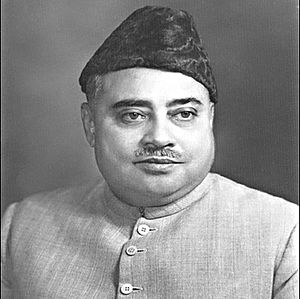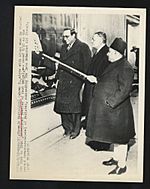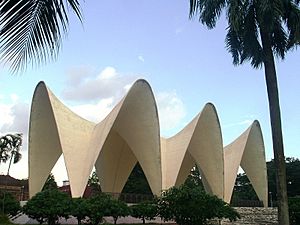Khawaja Nazimuddin facts for kids
Quick facts for kids
Khawaja Nazimuddin
|
|
|---|---|
| খাজা নাজিমুদ্দিন خواجہ ناظِمُ الدّین |
|

Khawaja Nazimuddin in 1948
|
|
| 2nd Governor-General of Pakistan | |
| In office 14 September 1948 – 17 October 1951 |
|
| Monarch | George VI |
| Prime Minister | Liaquat Ali Khan |
| Preceded by | Muhammad Ali Jinnah |
| Succeeded by | Malik Ghulam Muhammad |
| 2nd Prime Minister of Pakistan | |
| In office 17 October 1951 – 17 April 1953 |
|
| Monarch | George VI Elizabeth II |
| Governor General | Sir Malik Ghulam Muhammad |
| Preceded by | Liaquat Ali Khan |
| Succeeded by | Mohammad Ali Bogra |
| Chief Minister of East Bengal | |
| In office 15 August 1947 – 14 September 1948 |
|
| Monarch | George VI |
| Governor General | Muhammad Ali Jinnah |
| Prime Minister | Liaquat Ali Khan |
| Governor | Sir Fredrick Chalmers Bourne |
| Preceded by | Huseyn Suhrawardy (as Prime minister of Bengal) |
| Succeeded by | Nurul Amin |
| Prime Minister of Bengal | |
| In office 29 April 1943 – 31 March 1945 |
|
| Monarch | George VI |
| Governor General |
|
| Governor | Richard Casey, Baron Casey |
| Preceded by | Fazlul Haq |
| Succeeded by | Huseyn Suhrawardy |
| President of Muslim League | |
| In office 17 October 1951 – 17 April 1953 |
|
| Preceded by | Liaquat Ali Khan |
| Succeeded by | Mohammad Ali of Bogra |
| Personal details | |
| Born |
Khawaja Nazimuddin
19 July 1894 Dacca, Bengal Presidency, British India (now Dhaka, Bangladesh) |
| Died | 22 October 1964 (aged 70) Dacca, East Pakistan, Pakistan (now Dhaka, Bangladesh) |
| Resting place | Mausoleum of Three Leaders |
| Citizenship | British Indian (1894–1947) Pakistani (1947–1964) |
| Political party | Muslim League (1947–1958) |
| Other political affiliations |
All-India Muslim League (1922–1947) Pakistan Muslim League (1947–1964) |
| Spouse | Shahbano Ashraf |
| Relations | Khwaja Shahabuddin (Younger brother) |
| Alma mater | Cambridge University (MA) Aligarh Muslim University (BA) |
| Profession | Barrister, politician |
Sir Khawaja Nazimuddin (19 July 1894 – 22 October 1964) was an important Pakistani politician. He was the second Governor-General of Pakistan from 1948 to 1951. Later, he became the second Prime Minister of Pakistan from 1951 to 1953.
He was one of the people who helped create Pakistan. He was also the first Bengali person to lead Pakistan. Khawaja Nazimuddin came from a rich family in Bengal. He studied at Aligarh Muslim University and then at University of Cambridge in England.
When he returned, he joined politics with the All-India Muslim League. He first worked to improve education in Bengal. Later, he supported the idea of a separate homeland for Muslims, which became Pakistan. He became a key leader from Bengal and worked closely with Muhammad Ali Jinnah.
Before Pakistan was formed, he was the Prime Minister of Bengal from 1943 to 1945. After Pakistan's independence, he became the first Chief Minister of East Bengal. He became Governor-General in 1948 after Jinnah passed away. Then, in 1951, he became Prime Minister after Liaquat Ali Khan was assassinated.
His time as Prime Minister was challenging. There were disagreements with the Governor-General, Malik Ghulam Muhammad. Also, there were protests in Dhaka about the Bengali language in 1952. A year later, there were riots in Lahore. These events led to his dismissal in April 1953.
Khawaja Nazimuddin's government was the first federal government in Pakistan to be dismissed. After this, he left national politics. He passed away in 1964 and is buried in Dhaka.
Contents
Biography
Early Life and Education
Khawaja Nazimuddin was born on 19 July 1894 in Dhaka, which was then part of British India. His family was very wealthy and belonged to the Nawabs of Dhaka. His father was Khwaja Nizamuddin.
His family originally came from Kashmir but had lived in Dhaka for a long time. His mother was Nawabzadi Bilqis Banu. Khawaja Nazimuddin had a younger brother, Khwaja Shahabuddin, who also became important in Pakistani politics. His family spoke Persian, Urdu, and Bengali.
He went to Dunstable Grammar School in England. After that, he returned to British India. He studied at Aligarh Muslim University in India. There, he earned a bachelor's degree in sociology. He was also a good tennis player and played for his university.
After Aligarh, he went back to England. He studied at Trinity Hall, Cambridge at University of Cambridge. He earned a master's degree in English. His education in England allowed him to become a lawyer. He was knighted in 1934. Later, in 1947–49, he received an honorary Doctor of Laws degree from University of Dhaka.
Political Career
Public Service and Independence Movement
After finishing his studies, Khawaja Nazimuddin returned to India. He joined his brother, Khwaja Shahabuddin, in politics in Bengal. Both brothers joined the All-India Muslim League.
Nazimuddin was elected as the Chairman of Dhaka Municipality from 1922 to 1929. During this time, he became the Education Minister of Bengal. He worked to make primary education available to more people. He also helped farmers by introducing bills that freed them from debt.
In 1937, he ran in regional elections but lost. He became a member of the legislative assembly. He later became a close friend of Muhammad Ali Jinnah, the leader of the Muslim League. Jinnah appointed him to a committee to promote the Muslim League's goals.
Leader in Bengal
In 1943, Khawaja Nazimuddin became the Prime Minister of Bengal. He took over the government during a challenging time. He played a key role in supporting the idea of a separate Muslim homeland, which became Pakistan.
His time as Prime Minister ended in 1945. From 1945 to 1947, he continued to lead the Muslim League in Bengal. He strongly supported the creation of Pakistan.
After the Partition of India in 1947, Khawaja Nazimuddin became the first Chief Minister of East Bengal. He helped organize the new government in the province. He also led the vote for East Bengal to join the new country of Pakistan.
Governor-General of Pakistan (1948–1951)
On 14 August 1947, Pakistan became independent. Muhammad Ali Jinnah, the first Governor-General, also led the Pakistan Muslim League. After Jinnah's death, Khawaja Nazimuddin became the acting Governor-General on 14 September 1948.
As Governor-General, Nazimuddin tried to stay neutral and not interfere too much with the government. He supported Prime Minister Liaquat Ali Khan's government. This support was important for the government to work well. In 1949, he helped set up a committee to create a constitution for Pakistan.
Prime Ministership (1951–1953)

After Prime Minister Liaquat Ali Khan was assassinated in 1951, the leaders of the Muslim League asked Khawaja Nazimuddin to become Prime Minister. He also took over as the head of the party. He then appointed Malik Ghulam Muhammad as the new Governor-General.
Nazimuddin's government faced a difficult economy. There was also a rise in regional feelings in different parts of Pakistan. This made it hard for him to manage the country effectively. By 1951–52, the Muslim League party had split into different groups.
In 1951, Prime Minister Nazimuddin's government carried out Pakistan's first nationwide count of its people. It showed that many people in Karachi were refugees from India.
In January 1952, Nazimuddin announced that Urdu would be the official language of Pakistan. This led to protests in Dhaka, East Pakistan. On 21 February 1952, a demonstration for the Bengali language turned violent. Many people died when police fired on the protesters.
In 1953, there were also large protests and riots in Punjab. These protests were against the government. Prime Minister Nazimuddin tried to stop the violence. He declared martial law in Lahore, which means the military took control to restore order.
Dismissal
The protests and violence showed that Nazimuddin's government was struggling. Many people saw him as weak in managing the country. To try and improve the economy and security, Governor-General Malik Ghulam Muhammad asked Nazimuddin to step down.
Nazimuddin refused to resign. So, Malik Ghulam Muhammad used his powers to dismiss Nazimuddin on 17 April 1953. Nazimuddin tried to challenge this decision in court. However, the court did not rule on the dismissal's legality. Instead, it called for new elections.
Malik Ghulam Muhammad then appointed Muhammad Ali Bogra as the new prime minister. The dismissal of Khawaja Nazimuddin's government by the Governor-General was a significant event in Pakistan's political history.
Later Life and Legacy
Later Life and Death

Even after his dismissal, Khawaja Nazimuddin and his family remained involved in politics. His younger brother, Khwaja Shahabuddin, became an Information Minister later on.
Sir Khawaja Nazimuddin passed away in 1964 at the age of 70. He was buried in the Mausoleum of Three Leaders in his hometown of Dhaka.
Honours
Khawaja Nazimuddin received several honors during his life. In 1926, he was made a Companion of the Order of the Indian Empire (CIE). In 1934, King George V knighted him, making him a Knight Commander of the Order of the Indian Empire (KCIE).
In 1958, he received Pakistan's highest civilian award, the Nishan-e-Pakistan. After his death, many places were named after him. In Karachi, the areas of Nazimabad and North Nazimabad are named in his honor. In Islamabad, there is a road called Nazimuddin Road. There is also a road named after him in Dhaka.
Commemorative Postage Stamp
In 1990, the Pakistan Post issued a special postage stamp in his honor. It was part of their 'Pioneers of Freedom' series.
Images for kids
See also
 In Spanish: Khawaja Nazimuddin para niños
In Spanish: Khawaja Nazimuddin para niños
- List of prime ministers of Pakistan
- Politics of Pakistan
- Nawab of Dhaka


